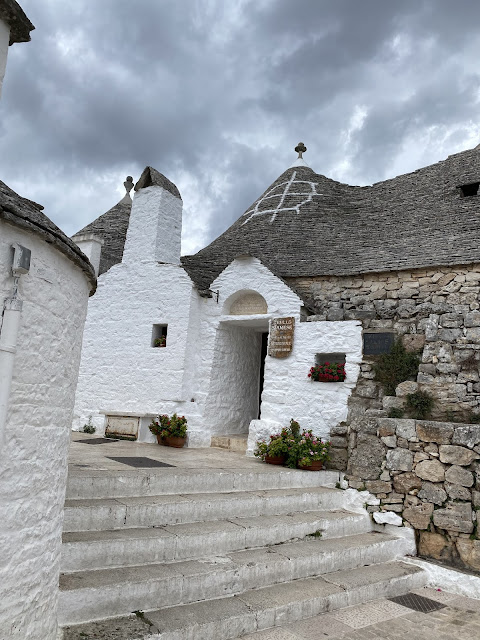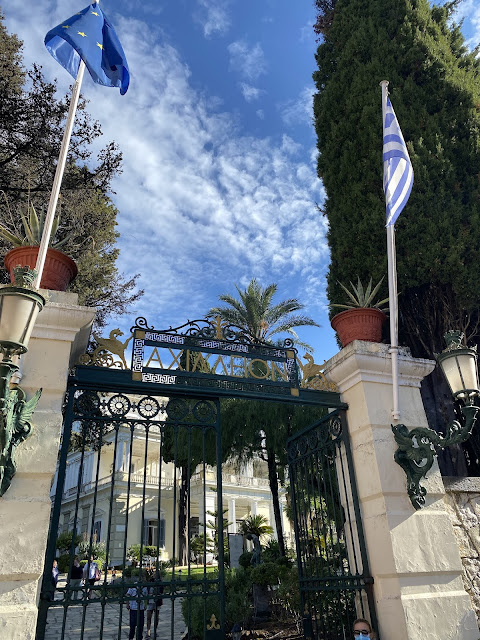We're repacking our bags for our trip home tomorrow. We'll leave Rome, fly to Paris, wait several hours, then arrive in Detroit around 6 p.m. It's been 2 months +, but it seems to have flown by. Here's the last of the stories about this trip:
Monday 10/11: We have rented a little 6-speed Fiat and headed out from Naples toward Puglia on the east (Adriatic Sea) coast of Italy's boot. Branko messages us that his car was fixed, he's on the ferry heading toward home, Skopje. It's a long drive for one day, but it doesn't stop him. Anne found a little Trulli or Trullo house for us in the countryside. The area is known for these little conical-roofed stone houses. Only the bedroom is actually Trulli style, but the house is comfy and has beautiful olive trees and a swimming pool, which will go unused by us this trip.
10/12: Today we take a long-awaited curvy panoramic drive southbound along the coast toward Italy's heel. The landscape is very rocky. Of course, olive trees thrive. Most of the crops have been harvested, but there are still fields with small orange melon or squash. In this environment, the prickly pear cactus grows big everywhere. Its fruit is turning red. We arrive at Santa Maria di Leuca, the tip, where the Ionian Sea meets the Adriatic. It's gorgeous! We drive in and out of the big cities of Lecce and Brindisi quickly. Too congested.
10/13: We're in the nearby town of Alberobello, the home of a majority of the Trulli houses; many of then house souvenir shops and restaurants. We split a dish of pasta. The waiter tells us the flour has been 'burnt', but we think he meant 'smoked'. Couldn't really tell with the pasta sauce.
10/14: We decide to head to Vieste, which is on the tip of a little peninsula jutting into the Adriatic. We regretably bypass the big port city of Bari. It's so congested. We were drawn to Bari when we learned of the WWII attack/disaster/accident involving nerve gas. Really, Google it and read about it! The Allies were secretly storing nerve gas on board ships in the port, when they were attacked by German bombs, unaware of the prescence of the gas onboard. Eisenhower, I think, and Churchill could not admit to the world -- and Germany -- that nerve gas was on board, so sailors and others injured were not treated for the type of wounds they had actually received. Maddening story. So, the tourist season is pretty much over, and most hotels and restaurants in this region are closed. It must be a madhouse in the summer.
10/15: We're driving west along the north peninsular coast, then we head north toward Pescara, our next stop. We see cabbage and sugar beets in the fields, lots of olive trees. An hour later around a bend in the road, we delightfully gasp when we see the gigantic snow-covered Apennines mountains. The Corno Grande is partially covered by the Calderone glacier, the only glacier in the Apennines. Pescara is a larger city, much more remains open. We like this location. And for all of you who know how much I hate snow and cold: I always say I only want to see snow on TV or in the movies. But I enjoyed seeing it here, far away in the distance.
10/16: We talked with a waiter at breakfast, Adriano Maggiore. Right away he asked where we were from in the U.S.; he knew our accent. We told him 'Michigan', and a big smile was on his face. 'Detroit!' His Maggiore grandfather was in Detroit during some of its heydays for 10 years, 1920-1929. He came back to Italy during the Depression when times were so tough. He originally arrived in Canada. But during a night, he crossed the Detroit River by boat into the U.S. A cop had been paid off by the Black Hand (look it up). He found work as a fine tailor for a clothing store or clothier called Marshall's, as Adriano remembers. He attended a Presbytrrian church in Detroit even though he was Catholic. He spent time in libraries. When he returned home, even with only a 3rd grade education, he was called 'Master' by his community, and he translated for the Army during WWII. He spoke English until he died in old age. The three of us enjoyed talking. We had received an email from the State Department, advising us of demonstrations throughout Italy against the Covid mandatory vaccination/testing policies/tightening regulations recently passed in the country. We headed out for a walk along the sea and walked past the small demonstration near our hotel. Minutes later, we joined a wreath laying commemoration attended by a couple dozen active and past military and government folks along with a couple priests at a memorial for the Air Force. We couldn't find any mention of a particular anniversary in the local news or on Google. We took our walk south to a pedestrian and bike bridge where we gaze st the Adriatic and turn around to see the sun shining on the snow covered mountains. We talked to a couple briefly: she was born in Rome, taken to Spain as an infant, and just returned to find a home in Italy. Her boyfriend was Polish. English was their common language. I forgot earlier to mention that Macedonian Branko and his wife speak English to their only granddaughter, in Slovakia, who is the daughter of a Macedonia father and Ukrainian mother who speak English together as their common language. Back at the hotel, we discover that the U.S. Army Air Force bombed the crap out of Pescara between 1943-1944, destroying 80% of the city, killing thousands of people. Oh my.. Pescara was the location of one of the most important marshalling yards in Central Italy for transit of supplies to Axis troops. Anne's travel purse fell apart about two weeks ago; today the strap rips out of my purse. We're really hard on purses.
10/17: This morning we read and watch reports of violent Covid demonstrations throughout Italy. Leaving the Adriatic Sea coast for the last time, we head west to Tivolli, driving through long tunnels through the Apennines. We discover the large UNESCO site Hadrian's Villa from the early 2nd C C.E. It's an amazing site. We learn that what remains of this site was bombed in WWII by Allied Forces. It just ain't right!!!
10/18: Anne and I had been discussing what we'll do if one of us doesn't pass the required Covid test for the flight home. We are tested at the Rome Airport. Fortunately we both have successful results for tomorrow's flight. We have an early departure to prepare for. As the photos my photographer has taken indicate, we have seen wonderful mountains, seas, old rocks (monasteries, forts, cobbled roads, Roman and Venetian ruins), met incredibly kind and interesting people, gave some love to some unfortunate animals. We enjoyed it all. We are so fortunate to have this opportunity. Thanks to everyone at home for helping us so we can leave home for two months and not worry about things. Thanks to Spiekermann Travel for arranging our Balkans travel & providing a great guide. Special thanks to my photographer, Anne. She does a great job! See you all soon.
A & M
And thanks to Maddy, my dear friend, great travel companion & writer - and a superb driver through all the mountainous, curvy roads!
Anne




















































